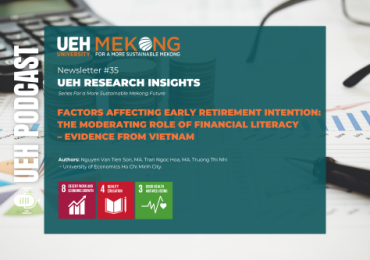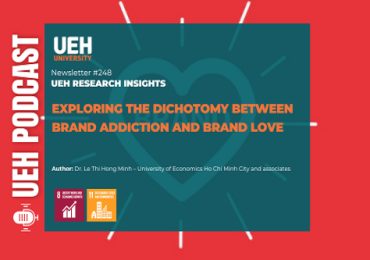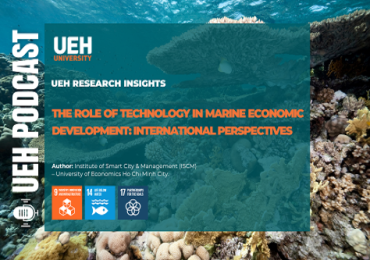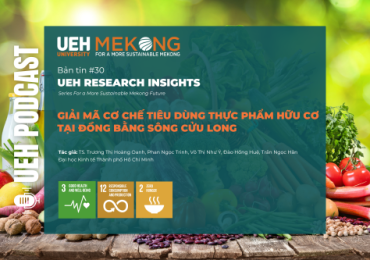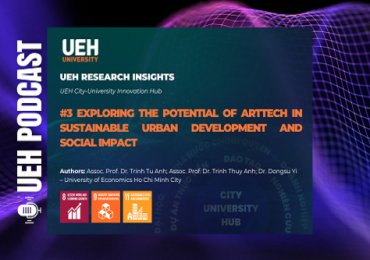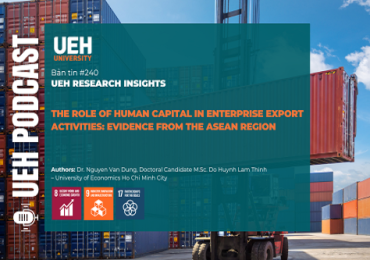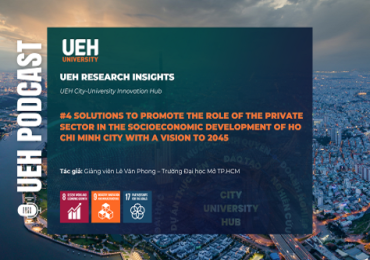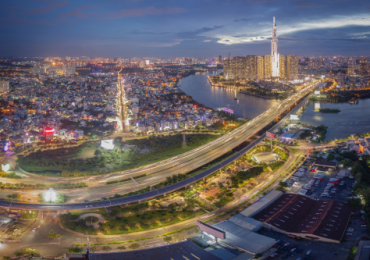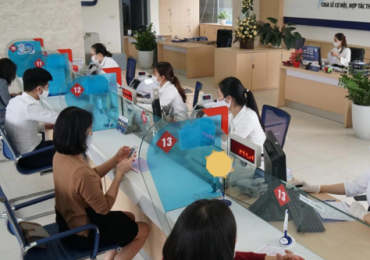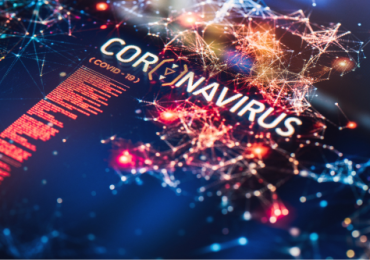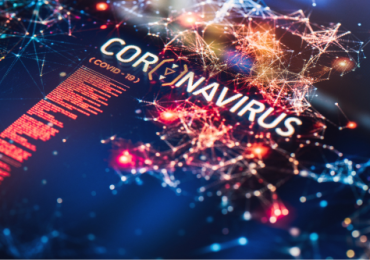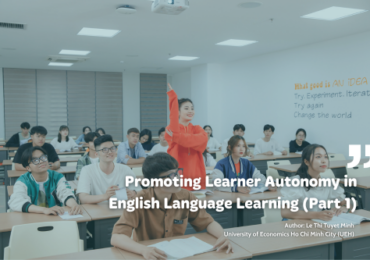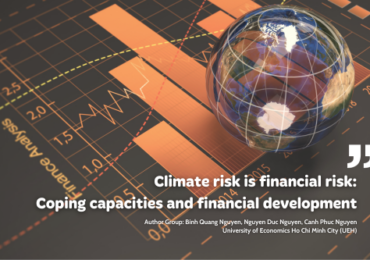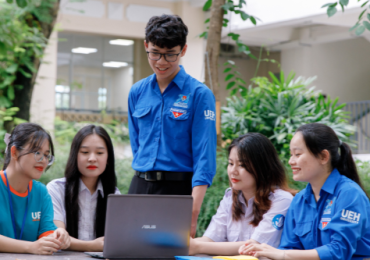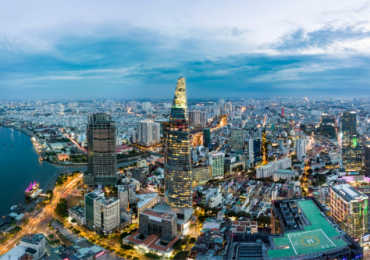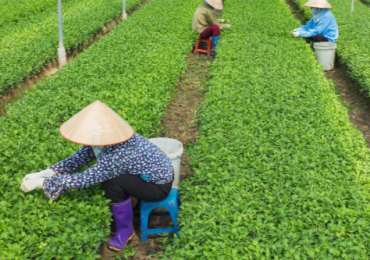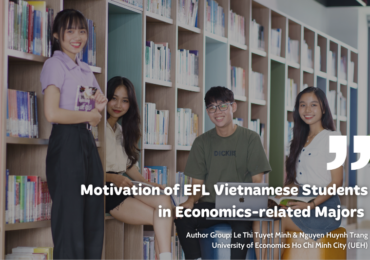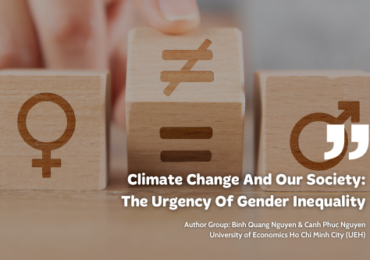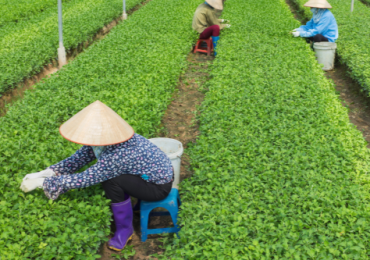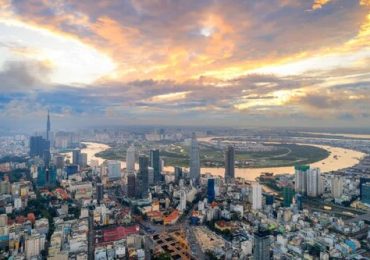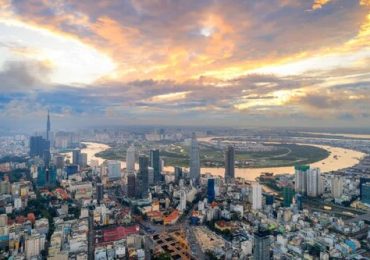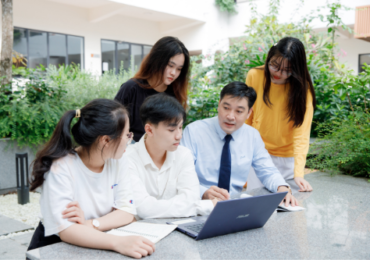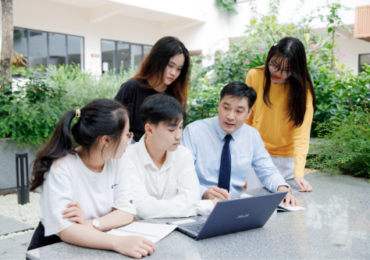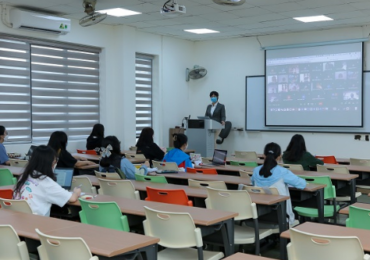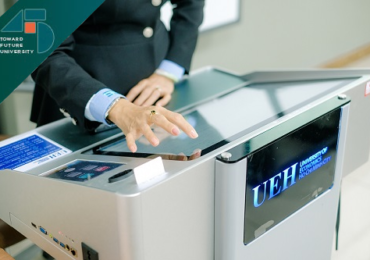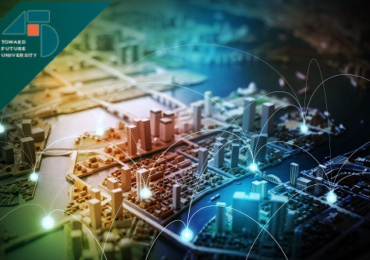[Research Contribution] Special Panel Discussion “AI and Innovation” at ArtTech Fusion 2024: Emerging Opportunities and Challenges in Art and Technology
5 July, 2025
Keywords: ArtTech Fusion, art and technology, sustainable development
As part of the academic knowledge-sharing and dissemination activities within the ArtTech Fusion series organized by the University of Economics Ho Chi Minh City (UEH), the panel discussion entitled “AI and Innovation” was convened under the moderation of Dr. Christopher Han, an expert in human-centered innovation, with the participation of distinguished speakers: Dr. Goh Chu Hiang, Dr. Dinh Binh Khanh, Mr. Matthew Alan Ward, and Mr. Nguyen Minh Quan. The discussion centered on the impact of Artificial Intelligence (AI) on art, design, and the creative industries, while also exploring potential solutions to navigate the emerging challenges of this technological era.

Innovation with AI in Art and Design

Figure 1. The Special Panel Discussion on “AI and Innovation”
Dr. Christopher Han, UEH’s Director of Innovation Strategy, opened the panel discussion by sharing insights into the role of Artificial Intelligence (AI) in advancing innovative initiatives within the field of art.

Figure 2. Dr. Christopher Han, Director of Innovation Strategy at the University of Economics Ho Chi Minh City (UEH)
According to Dr. Han, AI should not be perceived merely as a supportive tool, but rather as a transformative force capable of opening new directions for the fields of art and design. However, with the rapid advancements of AI technologies, critical questions have also emerged – particularly regarding whether the intrinsic value of art and design might be diminished as AI assumes a more prominent role in content creation.
Devaluing Art or Creating New Avenues for Innovation?
One of the central questions addressed during the discussion was: “Will AI diminish the value of artistic and design works?” According to Dr. Goh Chu Hiang, Senior Lecturer at the Faculty of Graphic Arts, Penang Academy of Arts, the advent of AI could potentially lead to the mass production of artistic products that lack personal expression and distinctive creativity. This phenomenon may give rise to a bifurcation within the art world: on one side, mass-produced popular art, and on the other, unique artistic expressions that bear the individual signature of the artist.

Figure 3. Dr. Goh Chu Hiang, Senior Lecturer at the Faculty of Graphic Arts, Penang Academy of Arts
However, Dr. Goh emphasized that human-centered art and design will always retain their fundamental value, asserting that AI should be regarded as a creative assistant, not as an originator of art. While AI can empower artists and designers by providing powerful tools to generate novel and experimental works, the core of creativity must remain grounded in human intention and direction.
Addressing the Challenges of AI in Art
While AI opens up new possibilities, Dr. Goh Chu Hiang also proposed several strategies to address the challenges it poses. One key solution lies in educating students and design professionals on how to harness AI as a tool for enhancing creativity, rather than viewing it as a competitor. Such an approach not only strengthens human creative capacity but also contributes to the production of more original and intellectually rich artistic works.
Furthermore, Dr. Goh highlighted the critical need to foster awareness and responsibility in data usage. Educating future artists and designers on concepts such as data transparency and ethical data practices will equip them to use AI in a thoughtful and conscientious manner, thereby mitigating the potential negative consequences of technological overreliance.
Preserving Local Cultural Values in the Age of AI
A significant challenge posed by AI is the risk of eroding local cultural values in art and design. According to Dr. Goh Chu Hiang, the proliferation of global software applications and AI platforms may accelerate cultural homogenization, thereby marginalizing traditional heritage and local aesthetics. Nonetheless, he also offered constructive solutions to this concern, such as integrating local cultural elements into AI education curricula and promoting community-based AI projects. These initiatives can contribute to the preservation and revitalization of cultural heritage in a digitally mediated world.

Figure 4. Dr. Goh presenting a project on preserving the cultural values of the Nurut ethnic group

Figure 5. Dr. Goh presenting a project on preserving the cultural values of the Nurut ethnic group
One compelling example shared by Dr. Goh involved the integration of indigenous symbols into mobile messaging systems as part of an emoji set, enabled by Artificial Intelligence (AI) technologies such as Natural Language Processing (NLP). This initiative demonstrates a meaningful intersection between tradition and modern technology, offering an innovative approach to preserving local cultural values within the digital environment.
The Impact of AI on Business and Practice
Mr. Nguyễn Minh Quân, Product Marketing Director at Samsung Vietnam, also contributed to the discussion by offering practical insights into the influence of AI in the business sector. According to Mr. Quân, AI is playing an increasingly pivotal role in the development of technological products, especially in the smartphone industry. AI-powered features integrated into Samsung’s latest product lines – particularly within the Galaxy AI ecosystem – have not only captured significant consumer attention but have also driven substantial growth in the company’s revenue streams.

Figure 6. Mr. Nguyễn Minh Quân, Product Marketing Director at Samsung Vietnam
Mr. Quân also noted that 58% of Samsung’s premium smartphone users cited AI as a primary reason for their purchasing decisions. He emphasized that the integration of AI features into technological products has contributed significantly to the company’s performance, resulting in a 15% increase in revenue during the first half of 2024.

Figure 7. Business performance resulting from the integration of AI into Samsung’s technological products
AI Applications in Performing Arts
Another compelling topic addressed during the panel discussion was the application of Artificial Intelligence in the performing arts. Mr. Matthew Alan Ward, an expert in cultural anthropology and performance art, shared his experiences of incorporating AI to enhance the creative process in live performances. According to Mr. Ward, AI not only improves technical aspects such as lighting and sound effects, but also enables real-time interaction with both performers and audiences. This dynamic interaction offers new artistic possibilities and redefines the traditional boundaries between technology and human expression in performance settings.

Figure 8. The collaboration between Shinehouse Troupe and AI
AI also facilitates the creation of unique and immersive performances, where movement, lighting design, music, and acting are intricately synchronized. A notable example is the performance of “Orange Grove Dance” at Voxel in Baltimore, USA, where AI was employed to coordinate lighting and movement throughout the choreography. This exemplifies how AI not only assists but also amplifies the creative capacities of performing arts, transforming how performances are conceptualized and experienced.
Conclusion: AI and Innovation in Art and Business
The “AI and Innovation” Special Panel Discussion at ArtTech Fusion 2024 offered thought-provoking insights into the transformative impact of Artificial Intelligence across the fields of art, design, and business. The discussion highlighted how AI is reshaping creative practices, enabling new forms of expression, and generating measurable business value. At the same time, it underscored the importance of maintaining human-centered approaches, cultural integrity, and ethical responsibility in navigating the challenges posed by rapid technological advancement.

Figure 9. Students actively participating in the program
The speakers collectively emphasized that Artificial Intelligence is not merely a supportive tool, but rather an integral component of the creative process. However, for AI to truly generate meaningful contributions, it is imperative to adopt a balanced and human-centered approach – one that positions AI as a facilitator of human creativity, rather than as a replacement for it. Furthermore, in the context of the digital age, the preservation and promotion of local cultural values must be prioritized. This dual focus on technological advancement and cultural sustainability is essential to ensure that innovation through AI remains inclusive, ethical, and culturally grounded.

Figure 10. The Organizing Committee of ATF24 presenting gifts to the guest speakers

Figure 11. Students and guest speakers posing for a commemorative photo
| As part of the global development trend in the ArtTech field, the ArtTech Fusion (ATF) international event series is organized annually by the ArtTech Hub (ATH) in collaboration with various domestic and international partners. The event is hosted by units under the UEH College of Technology and Design (CTD), University of Economics Ho Chi Minh City (UEH), with a different central theme each year.
In 2024, the ArtTech Fusion series was held under the theme “New ArtTech for Future Generations”, aiming to inspire and promote creative thinking and innovative action among future generations while contributing to the building of a sustainable society. The ATF24 journey took place over three days (October 22–24, 2024), featuring more than 30 academic and practical activities, including 5 keynote speeches, 10 special panel sessions, 5 parallel research presentations, 5 workshops, 1 academic book chapter publication, 9 exhibitions, 1 heritage connection trip, and 1 tangible art performance. In 2025, the ArtTech Fusion series will return for its fourth edition (ATF25) under the theme “Co-Creation for a Wondrous Future”, scheduled to take place from September 24 to 26, 2025. The event will be an opportunity to explore, experience, interact, and co-create within the enchanting realm of technology-integrated art, all with a shared vision toward a sustainable future. For more updates about ATF25, please visit: Website: https://ath.ueh.edu.vn/ |
Author: Assoc. Prof. Dr. Trinh Thuy Anh – Faculty of Media Design – University of Economics Ho Chi Minh City (UEH)
This article is part of the series “UEH Research and Knowledge Dissemination Series”, under the message “Research Contribution For All – Nghiên cứu vì cộng đồng”. UEH respectfully invites readers to look forward to upcoming editions of the UEH Research Insights newsletter.
Content and images: Provided by the author and the UEH Department of Communications and Partnerships

[Podcast] Recommendations for University education development
14 February, 2025
[Podcast] Developing Vung Tau into a World-Class Tourism City
16 January, 2025
[Podcast] Postdigital Design Strategies for Media Art
6 January, 2025
[Podcast] NFTs – Artistic Innovation or Just a New Hype?
27 December, 2024
[Podcast] Boosting Employee Creativity with Constructive Feedback
23 November, 2024
[Podcast] “Dutch Disease” in Remittances and the Case of Vietnam
4 November, 2024
[Podcast] Latest approaches for sustainable universities
11 July, 2024
Data Law – Part 1: Necessity for a New Approach
18 May, 2024
Advertising Evaluation on Tiktok Platform
14 May, 2024
[Podcast] Advertising Evaluation on Tiktok Platform
13 May, 2024
Promoting Learner Autonomy in English Language Learning (Part 1)
24 November, 2023
ArtTech And Sustainable Development
27 October, 2023
Motivation of EFL Vietnamese Students in Economics-related Majors
12 October, 2023
Climate Change And Our Society: The Urgency Of Gender Inequality
12 October, 2023
People Analytics in Vietnam
10 March, 2022
Revolution in Experimental Economics
30 January, 2022
The Sharing Economy: Governance Issues in Vietnam
24 January, 2022
Employment Policy For Ho Chi Minh City in Post-social distancing Period
28 December, 2021
Lifelong learning at UEH: Towards a Sustainable University
28 December, 2021
Building a Decentralized Stock Market based on Blockchain Technology
24 December, 2021
Consumer price index from big data mining perspective (Big data)
17 November, 2021
Overview Of Digital Currency – Part 5: DIEM Private Stabilized Currency
11 November, 2021

